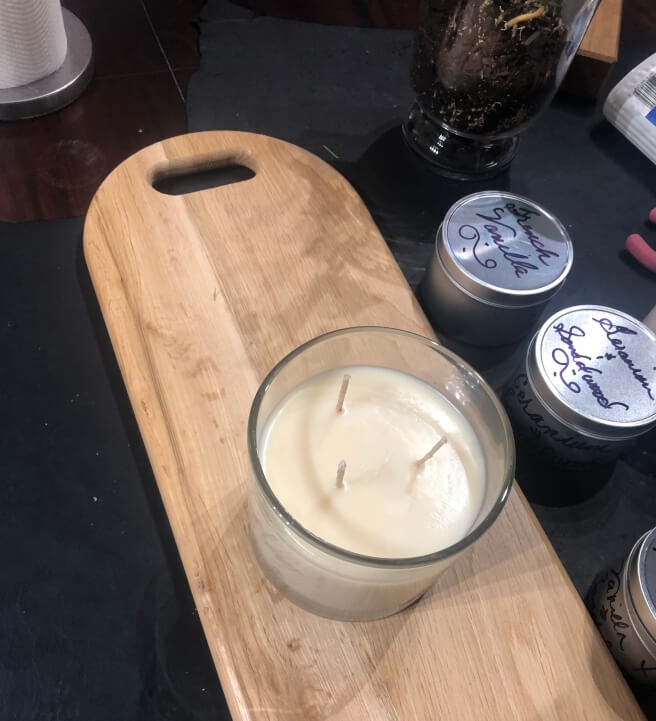Do you experience coughing and irritation when burning candles? If so, you are not alone. Many individuals have reported experiencing respiratory issues when exposed to the ingredients in commercial candles. In this article, we will explore the science behind candle ingredients and their effects on indoor air quality, as well as natural alternatives for non-toxic candle making.
When it comes to creating a cozy and inviting atmosphere in our homes, candles are often the go-to choice. However, what many people may not realize is that the ingredients used in commercial candles can release harmful toxins into the air when burned. Understanding the impact of these materials on our indoor air quality is essential for creating a healthier home environment.
We will also delve into the environmental impact of commercial candles and provide tips for reducing coughing and irritation from candle smoke. Additionally, we will explore DIY candle making as a healthier and safer alternative to commercial options, along with choosing the right wick and fragrances for individuals with sensitivities. By making conscious candle choices, you can create a healthier home environment for yourself and your loved ones.
Common Candle-Making Materials and Their Effects on Indoor Air
When it comes to candle-making materials, it’s important to consider the potential effects on indoor air quality. Many commonly used ingredients in commercial candles can release harmful compounds into the air when burned, contributing to respiratory issues such as coughing and irritation. Understanding the impact of these materials is crucial for making informed choices about the candles we bring into our homes.
Paraffin Wax
One of the most widely used materials in commercial candle-making is paraffin wax, a byproduct of petroleum refining. When paraffin wax candles are burned, they can release a range of volatile organic compounds (VOCs) into the air, including toluene and benzene. These chemicals have been linked to respiratory issues and can exacerbate conditions such as asthma.
Fragrances and Additives
Many commercially available candles are scented with synthetic fragrances and contain additives such as colorants and stabilizers. These additives can also emit VOCs when burned, contributing to indoor air pollution. For individuals who are sensitive to chemicals, these emissions can trigger coughing and other respiratory symptoms.
Metal Wicks
In addition to the wax and fragrance components, the type of wick used in a candle can also impact indoor air quality. Some metal wicks contain lead, which can release toxic fumes when burned. Even small amounts of lead exposure from candle emissions over time can pose health risks, leading to coughing and other symptoms.
By understanding the potential impact of these common candle-making materials on indoor air quality, consumers can make more conscious choices about the products they bring into their homes. In the next section, we will explore natural alternatives for non-toxic candle making that can help reduce these harmful effects.
Environmental Impact of Commercial Candles
Commercial candles are a popular household item, often used for ambiance, scent, and relaxation. However, the ingredients in these candles can have an impact on indoor air quality and the environment. Many commercial candles contain paraffin wax, which when burned, can release harmful chemicals such as toluene and benzene into the air. These chemicals can contribute to indoor air pollution, leading to coughing and irritation for sensitive individuals.
In addition to paraffin wax, commercial candles also often contain synthetic fragrances and dyes that can emit volatile organic compounds (VOCs) when burned. These VOCs can aggravate respiratory conditions and contribute to poor indoor air quality. Furthermore, the production of commercial candles often involves the use of fossil fuels, contributing to carbon emissions and environmental pollution.
As consumers become more conscious of the impact of their purchasing choices on their health and the environment, there is a growing interest in natural alternatives for non-toxic candle making. This shift is driving increased demand for environmentally friendly materials such as soy wax, beeswax, and essential oils for fragrance. By choosing natural alternatives, consumers can reduce their exposure to harmful chemicals while also lowering their carbon footprint.
| Commercial Candle Ingredients | Effects on Indoor Air Quality |
|---|---|
| Paraffin Wax | Release of harmful chemicals such as toluene and benzene |
| Synthetic Fragrances and Dyes | Emission of volatile organic compounds (VOCs) |
| Fossil Fuel Production | Contribution to carbon emissions and environmental pollution |
Natural Alternatives for Non-Toxic Candle Making
When it comes to creating non-toxic candles, natural alternatives can be a great option for those who are sensitive to the chemicals typically found in commercial candles. Making your own candles using natural ingredients not only reduces the risk of coughing and irritation, but also allows you to customize the scents and colors according to your preferences.
Here are some natural alternatives for non-toxic candle making:
- Beeswax: Beeswax is a popular choice for making non-toxic candles as it is all-natural, sustainable, and burns clean without emitting harmful substances into the air.
- Soy Wax: Soy wax is another great alternative as it is derived from soybean oil and is free from toxins. It has a longer burn time compared to paraffin wax and produces less soot.
- Coconut Oil: Using coconut oil as a base for candles not only produces a clean burn but also offers a subtle tropical aroma when mixed with essential oils or natural fragrance extracts.
When choosing natural alternatives for non-toxic candle making, it is important to consider the source of the ingredients and whether they have been responsibly harvested. Additionally, using essential oils or natural fragrance extracts instead of synthetic fragrances can further enhance the non-toxic qualities of homemade candles.
By opting for natural alternatives in candle making, individuals can enjoy the ambiance and relaxation that candles provide without worrying about inhaling harmful chemicals that may result in coughing or irritation. Ultimately, creating non-toxic candles at home allows for a healthier indoor environment while indulging in the soothing effects of candlelight.
Tips for Reducing Coughing and Irritation From Candles
When it comes to enjoying the cozy ambiance of burning candles, many people experience coughing and irritation. This can be attributed to the ingredients and materials used in commercial candles, which release harmful substances into the air when burned. One common culprit is paraffin wax, a byproduct of petroleum that can emit toxins like benzene and toluene when lit. These chemicals can cause respiratory issues and aggravate existing conditions such as asthma.
To reduce coughing and irritation from candles, consider opting for natural alternatives such as soy or beeswax candles. These materials burn cleaner and produce less soot compared to paraffin wax, leading to improved indoor air quality. Additionally, natural essential oils can be used for fragrance instead of synthetic scents, further reducing the risk of respiratory irritation.
Another tip for minimizing coughing from candles is to ensure proper ventilation in the room where they are being burned. Opening windows or using an air purifier can help dissipate any potential irritants released by the candle into the air. This is especially important for individuals with sensitivities to certain fragrances or chemicals commonly found in commercial candles.
Furthermore, choosing candles with cotton wicks over metal-core wicks can also contribute to a healthier indoor environment. Metal-core wicks have been found to release lead into the air when burned, posing serious health risks. By making conscious choices about the materials and fragrances used in candles, individuals can create a safer and more enjoyable atmosphere in their homes without experiencing coughing or respiratory irritation.
| Tips for Reducing Coughing | & Irritation From Candles |
|---|---|
| Opt for natural alternatives like soy or beeswax candles | Use essential oils for fragrance instead of synthetic scents |
| Ensure proper ventilation in the room where candles are burned | Choose cotton wicks over metal-core wicks |
DIY Candle Making
Benefits of DIY Candle Making
DIY candle making can offer a healthier and safer alternative to commercial candles. By making your own candles, you have more control over the ingredients used, ensuring that they are non-toxic and free from harmful chemicals. This can significantly reduce the risk of coughing and irritation caused by traditional candles.
Non-Toxic Ingredients for DIY Candles
When making your own candles, it’s important to choose natural and non-toxic materials. Opt for soy wax, beeswax, or coconut oil as a base instead of paraffin wax, which can release harmful toxins into the air when burned. Additionally, use essential oils for fragrance instead of synthetic fragrances, which often contain phthalates and other potentially harmful chemicals. By using these non-toxic ingredients, you can create a safer environment for yourself and your family.
Creating Your Own Non-Irritating Candles
For individuals who are sensitive to certain scents or have respiratory issues such as asthma, DIY candle making provides the opportunity to customize candles that won’t trigger coughing or irritation. You can experiment with different waxes, fragrances, and wicks to find the perfect combination that suits your needs without causing any adverse effects. With DIY candle making, you can enjoy the ambiance of burning candles without compromising your health.
Choosing the Right Wick and Fragrances for Sensitive Individuals
When it comes to choosing the right wick and fragrances for sensitive individuals, it’s important to consider the potential impact on indoor air quality and respiratory health. Certain candle ingredients and materials can release harmful pollutants into the air, leading to coughing and irritation, especially for those with sensitivities. Here are some factors to consider when selecting candles for a healthier home environment:
- Wick Materials: Opt for candles with wicks made from natural materials such as cotton or wood, as they produce less soot and harmful emissions compared to synthetic wicks.
- Fragrance Selection: Avoid candles with strong artificial fragrances that can trigger respiratory issues. Instead, look for candles scented with natural essential oils, which are less likely to cause coughing or irritation.
In addition to choosing the right wick and fragrances, sensitive individuals should also be mindful of the size of the candle and the space in which it is being burned. Smaller candles in well-ventilated areas can help minimize the impact on indoor air quality.
Lastly, it’s important to pay attention to any warnings or labels on candle products, as they often provide valuable information about potential health risks associated with specific ingredients or materials. By making conscious choices when selecting candles, individuals with sensitivities can enjoy a cozy and fragrant atmosphere without compromising their respiratory health.
Conclusion
In conclusion, it is evident that the ingredients in conventional candles can have a negative impact on indoor air quality, leading to issues such as coughing and irritation. The use of paraffin wax, synthetic fragrances, and lead-core wicks can release harmful toxins into the air, posing health risks for individuals with respiratory sensitivities. The environmental impact of commercial candles further emphasizes the need for conscious candle choices to create a healthier home environment.
However, there are natural alternatives available for those looking to eliminate the effects of traditional candle making materials on indoor air quality. By using non-toxic ingredients such as soy or beeswax, essential oils, and cotton wicks, individuals can reduce their exposure to harmful compounds while still enjoying the ambiance of a flickering flame.
DIY candle making provides an opportunity for individuals to customize their candles with safer options, ensuring that they are free from irritants that may cause coughing or other health issues.
It is crucial for sensitive individuals to choose the right wicks and fragrance options when purchasing or making candles. By selecting lead-free wicks and opting for essential oils or natural fragrances, individuals can minimize the risk of respiratory irritation and enjoy their favorite scents without compromising their health. With conscious candle choices and mindful considerations, it is possible to create a healthier home environment that promotes well-being and comfort for all occupants.

Welcome to my candle making blog! In this blog, I will be sharing my tips and tricks for making candles. I will also be sharing some of my favorite recipes.


